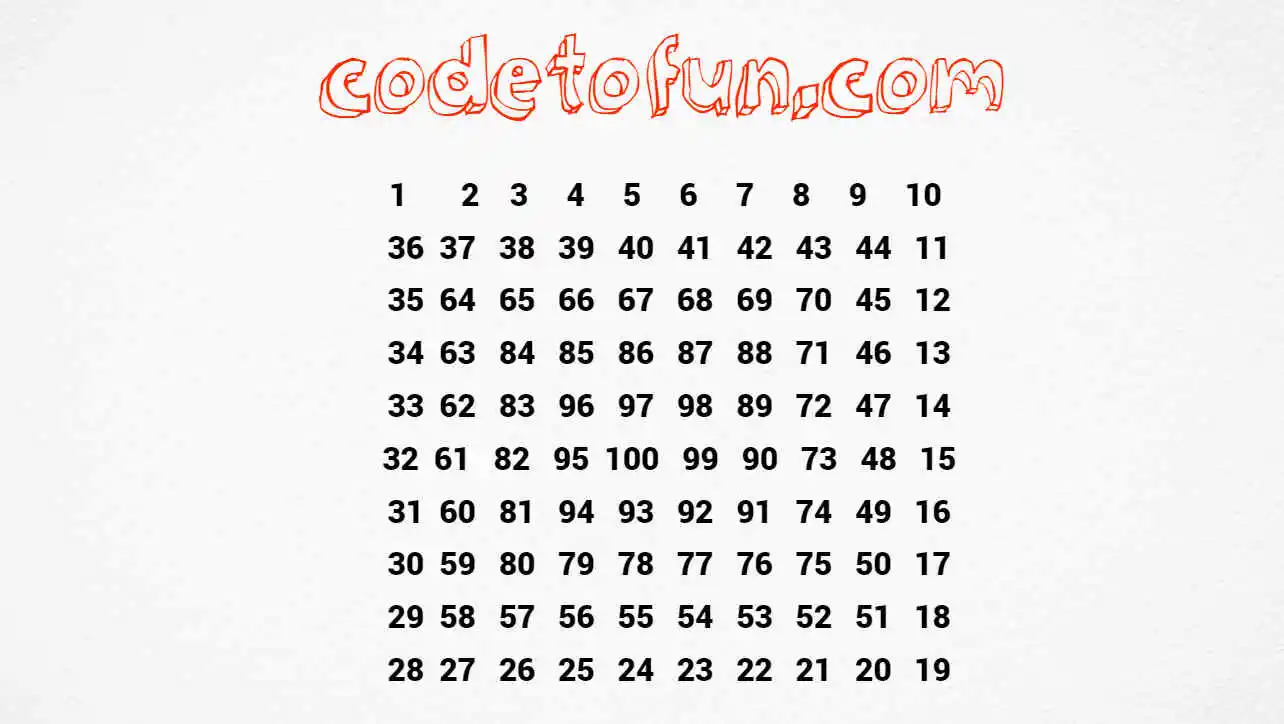
C++ Topics
- C++ Intro
- C++ String Functions
- C++ Interview Programs
- C++ Star Pattern
- C++ Number Pattern
- Number Pattern 1
- Number Pattern 2
- Number Pattern 3
- Number Pattern 4
- Number Pattern 5
- Number Pattern 6
- Number Pattern 7
- Number Pattern 8
- Number Pattern 9
- Number Pattern 10
- Number Pattern 11
- Number Pattern 12
- Number Pattern 13
- Number Pattern 14
- Number Pattern 15
- Number Pattern 16
- Number Pattern 17
- Number Pattern 18
- Number Pattern 19
- Number Pattern 20
- Number Pattern 21
- Number Pattern 22
- Number Pattern 23
- Number Pattern 24
- Number Pattern 25
- Number Pattern 26
- Number Pattern 27
- Number Pattern 28
- Number Pattern 29
- Number Pattern 30
- Number Pattern 31
- Number Pattern 32
- Number Pattern 33
- Number Pattern 34
- Number Pattern 35
- Number Pattern 36
- Number Pattern 37
- Number Pattern 38
- Number Pattern 39
- Number Pattern 40
- Number Pattern 41
- Number Pattern 42
- Number Pattern 43
- Number Pattern 44
- Number Pattern 45
- Number Pattern 46
- Number Pattern 47
- Number Pattern 48
- Number Pattern 49
- Number Pattern 50
- Number Pattern 51
- Number Pattern 52
- Number Pattern 53
- Number Pattern 54
- Number Pattern 55
- Number Pattern 56
- Number Pattern 57
- Number Pattern 58
- Number Pattern 59
- Number Pattern 60
- Number Pattern 61
- Number Pattern 62
- C++ Alphabet Pattern
C++ Number Pattern 62

Photo Credit to CodeToFun
C++ Number Pattern 62
Here`s a program that prints the above number pattern using C++ Programming:
#include <iostream>
#include <iomanip>
using namespace std;
int main() {
int a[10][10], i, j, low = 0, high = 9, n = 1;
for (i = 0; i < 5; i++, low++, high--) {
for (j = low; j <= high; j++, n++)
a[i][j] = n;
for (j = low + 1; j <= high; j++, n++)
a[j][high] = n;
for (j = high - 1; j >= low; j--, n++)
a[high][j] = n;
for (j = high - 1; j > low; j--, n++)
a[j][low] = n;
}
cout << "\t\tPerfect Square Spiral\n";
for (i = 0; i < 10; i++) {
cout << "\n";
for (j = 0; j < 10; j++)
cout << setw(4) << a[i][j];
cout << "\n";
}
return 0;
}💻 Testing the Program
When you run the above program, it will print the following output:
1 2 3 4 5 6 7 8 9 10 36 37 38 39 40 41 42 43 44 11 35 64 65 66 67 68 69 70 45 12 34 63 84 85 86 87 88 71 46 13 33 62 83 96 97 98 89 72 47 14 32 61 82 95 100 99 90 73 48 15 31 60 81 94 93 92 91 74 49 16 30 59 80 79 78 77 76 75 50 17 29 58 57 56 55 54 53 52 51 18 28 27 26 25 24 23 22 21 20 19
🧠 How the Program Works
Let's break down the logic behind the code:
- The program includes the necessary header files, iostream for input/output and iomanip for setting the output format.
- The using namespace std; statement allows the program to use names from the std namespace without explicitly specifying it.
- The main() function is the entry point of the program.
- It declares a 2D array int a[10][10] to store the spiral pattern and initializes some variables i, j, low, high, and n.
- The program uses a series of loops to fill the array with numbers in a perfect square spiral pattern. The outer loop runs 5 times (for(i=0; i<5; i++, low++, high--)) because there will be 5 spirals within the 10x10 matrix. The low and high variables are used to define the boundaries of the spiral for each iteration.
- Within each iteration of the outer loop, there are four inner loops that fill the matrix with numbers in the spiral pattern:
- The first inner loop (for(j=low; j<=high; j++, n++)) fills the top row of the spiral from left to right.
- The second inner loop (for(j=low+1; j<=high; j++, n++)) fills the rightmost column of the spiral from top to bottom.
- The third inner loop (for(j=high-1; j>=low; j--, n++)) fills the bottom row of the spiral from right to left.
- The fourth inner loop (for(j=high-1; j>low; j--, n++)) fills the leftmost column of the spiral from bottom to top.
- After filling the array with the perfect square spiral pattern, the program prints the matrix in a formatted way to display the spiral pattern. It first prints a title, "Perfect Square Spiral."
- The program then uses nested loops to iterate over the a array and prints its contents using cout and setw(4) (which sets the width of each number printed to 4 characters). This formatting makes the output look like a neat grid.
- Finally, the main() function returns 0, indicating successful program execution.
💯 Tips for Enhancement:
Explore the versatility of this pattern by adjusting its parameters. Whether you increase or decrease the size, tweak the spacing, or modify the characters used, each change opens up a world of possibilities, allowing you to customize and create your unique visual effects.
✔ Conclusion:
Creating visually appealing patterns is not only a fun endeavour but also a great way to enhance your programming or design skills. We hope this tutorial has inspired you to explore the world of creative coding. Share your creations with us, and let your imagination run wild!
🤗 Closing Call-to-Action:
We'd love to see your unique interpretations of the number pattern. Share your creations in the comments below, and don't hesitate to reach out if you have any questions or suggestions for future tutorials. Happy coding!
👨💻 Join our Community:
Author

For over eight years, I worked as a full-stack web developer. Now, I have chosen my profession as a full-time blogger at codetofun.com.
Buy me a coffee to make codetofun.com free for everyone.
Buy me a Coffee












If you have any doubts regarding this article (C++ Number Pattern 62) please comment here. I will help you immediately.